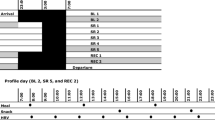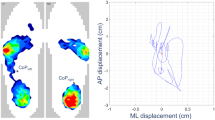Abstract
Background
Sleeping with the head of bed tilted upwards (SHU) is recommended as a treatment of orthostatic hypotension though the supporting evidence is weak.
Aim
To investigate the physiological effects of SHU amongst a group of young healthy volunteers.
Methods
Twenty-nine volunteers, mean age 22 years, underwent 1-week of SHU at 18-in. elevation. Before and after hemodynamic and non-haemodynamic parameters were recorded.
Results
After SHU, there were reductions in the systolic blood pressure drop on standing, upright total peripheral resistance, haemoglobin, nocturnal urinary volume, orthostatic dizziness and increases in weight, standing cardiac output and ankle circumference. There were no differences in heart rate, stroke volume, renin, aldosterone, pro-atrial natriuretic peptide or 24-h blood pressure.
Conclusions
In these healthy subjects, SHU for 1 week had a nocturnal antidiuretic effect with both intra- and extra-vascular accumulation of fluid and was associated with reduced postural drop in SBP and improved orthostatic tolerance.


Similar content being viewed by others
References
The Consensus Committee of the American Autonomic Society and the American Academy of Neurology (1996) Consensus statement on the definition of orthostatic hypotension, pure autonomic failure, and multiple system atrophy. Neurology 46(5):1470
Hussain RM, McIntosh SJ, Lawson J, Kenny RA (1996) Fludrocortisone in the treatment of hypotensive disorders in the elderly. Heart 76(6):507–509
Chaimberg KH, Travis KW (2002) Supine hypertension during general anesthesia in a patient taking midodrine. Anesth Analg 95(5):1196–1197 table of contents
Sandroni P, Benarroch EE, Wijdicks EF (2001) Caudate hemorrhage as a possible complication of midodrine-induced supine hypertension. Mayo Clin Proc 76(12):1275
Pathak A, Raoul V, Montastruc JL, Senard JM (2005) Adverse drug reactions related to drugs used in orthostatic hypotension: a prospective and systematic pharmacovigilance study in France. Eur J Clin Pharmacol 61(5–6):471–474
Shannon JR, Diedrich A, Biaggioni I et al (2002) Water drinking as a treatment for orthostatic syndromes. Am J Med 112(5):355–360
Mathias CJ (2000) A 21st century water cure. Lancet 356(9235):1046–1048
Cariga P, Mathias CJ (2001) Haemodynamics of the pressor effect of oral water in human sympathetic denervation due to autonomic failure. Clin Sci 101(3):313–319
Claydon VE, Hainsworth R (2004) Salt supplementation improves orthostatic cerebral and peripheral vascular control in patients with syncope. Hypertension 43(4):809–813
Shichiri M, Tanaka H, Takaya R, Tamai H (2002) Efficacy of high sodium intake in a boy with instantaneous orthostatic hypotension. Clin Auton Res 12(1):47–50
Krediet CT, Wieling W (2003) Manoeuvres to combat vasovagal syncope. Europace 5(3):303
Brignole M, Alboni P, Benditt DG et al (2004) Guidelines on management (diagnosis and treatment) of syncope—update 2004. Europace 6(6):467–537
Bradley JG, Davis KA (2003) Orthostatic hypotension. Am Fam Physician 68(12):2393–2398
Oldenburg O, Kribben A, Baumgart D, Philipp T, Erbel R, Cohen MV (2002) Treatment of orthostatic hypotension. Curr Opin Pharmacol 2(6):740–747
Mathias CJ, Bannister R (2002) Management of postural hypotension. In: Bannister R, Mathias CJ (eds) Autonomic failure: a textbook of clinical disorders of the autonomic nervous systems. Oxford Medical Publications, Oxford, pp 342–356
Fan CW, Coakley D, Walsh JB, Cunningham CJ (2006) Postal questionnaire survey: the use of sleeping with the head of the bed tilted upright for treatment of orthostatic hypotension in clinical practice. Age Ageing 35(5):529–532
MacLean AR, Allen EV (1940) Orthostatic hypotension andorthostatic tacchycardia: treatment with the ‘head-up’ bed. J Am Med Assoc 115:2162–2167
Corcoran AC, Browning JS, Page IH (1943) Renal hemodynamics in orthostatic hypotension: effects of angiotonin and head-up bed. J Am Med Assoc 119(10):793–794
Ten Harkel AD, Van Lieshout JJ, Wieling W (1992) Treatment of orthostatic hypotension with sleeping in the head-up tilt position, alone and in combination with fludrocortisone. J Intern Med 232(2):139–145
van Lieshout JJ, Ten Harkel AD, Wieling W (2000) Fludrocortisone and sleeping in the head-up position limit the postural decrease in cardiac output in autonomic failure. Clin Auton Res 10(1):35–42
Wieling W, Karemaker JM (2002) Measurement of heart rate and blood pressure to evaluate disturbances in neurocardiovascular control, 4th edn. Oxford Medical Publications, Oxford
Wesseling KH, Jansen JR, Settels JJ, Schreuder JJ (1993) Computation of aortic flow from pressure in humans using a nonlinear, three-element model. J Appl Physiol 74(5):2566–2573
Walters J, Garrity P (2003) Performance evaluation of the Sysmex XE-2100 Hematology Analyzer. Lab Hematol 6:83–92
Palatini P, Frigo G, Bertolo O, Roman E, Da Corta R, Winnicki M (1998) Validation of the A&D TM-2430 device for ambulatory blood pressure monitoring and evaluation of performance according to subjects’ characteristics. Blood Press Monit 3(4):255–260
Bannister R, Ardill L, Fentem P (1969) An assessment of various methods of treatment of idiopathic orthostatic hypotension. Q J Med 38(152):377–395
Wilcox CS, Aminoff MJ, Penn W (1974) Basis of nocturnal polyuria in patients with autonomic failure. J Neurol Neurosurg Psychiatry 37(6):677–684
Mathias CJ, Fosbraey P, da Costa DF, Thornley A, Bannister R (1986) The effect of desmopressin on nocturnal polyuria, overnight weight loss, and morning postural hypotension in patients with autonomic failure. Br Med J (Clin Res Ed) 293(6543):353–354
Bannister R, Mathias CJ (1992) Management of postural hypotension. In: Autonomic failure: a textbook of clinical disorders of the autonomic nervous system. Oxford Medical Publications, Oxford
Henry R, Rowe J, O’Mahony D (1999) Haemodynamic analysis of efficacy of compression hosiery in elderly fallers with orthostatic hypotension. Lancet 354(9172):45–46
Mathias CJ, Kimber JR (1998) Treatment of postural hypotension. J Neurol Neurosurg Psychiatry 65(3):285–289
Author information
Authors and Affiliations
Corresponding author
Rights and permissions
About this article
Cite this article
Fan, C.W., O’Sullivan, E., Healy, M. et al. Physiological effects of sleeping with the head of the bed elevated 18 in. in young healthy volunteers. Ir J Med Sci 177, 371–377 (2008). https://doi.org/10.1007/s11845-008-0233-0
Received:
Accepted:
Published:
Issue Date:
DOI: https://doi.org/10.1007/s11845-008-0233-0




